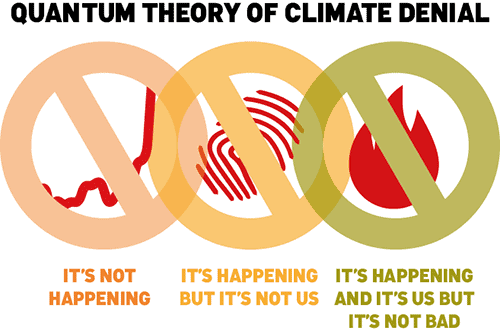A group used statistical tools to replicate the findings of 38 papers that refute man-made climate change. There’s a 97% consensus among experts that the climate is being altered by man-made activities, and only 2-3% of published papers refute this established hypothesis. Instead, they cite anything from solar cycles, to ocean currents to the motion of the planets to explain for the rapid rate with which surface and ocean temperatures have risen over the past 100 years (unheard of in a geological timeline). Since there is no one single hypothesis proposed to explain global warming, but a myriad, this in itself should make us feel skeptical of papers refuting climate change. Indeed, when the researchers analyzed some of the most cited contrarian climate change papers — by other scientists or in the media — they found these were riddled with methodological errors and not one one of them stood to scrutiny.

The study was authored by Rasmus Benestad, Dana Nuccitelli, Stephan Lewandowsky, Katharine Hayhoe, Hans Olav Hygen, Rob van Dorland, and John Cook. They devised an analytical tool using the R programming language replicate and test the results and methods used in these studies.
Most papers failed because they cherry picked their data. Writing for The Guardian, Nuccitelli cites as an example a paper published in 2011 by Humlum et al. that found lunar and solar cycles can be identified as sources of global warming. The simulated data proved to be accurate in their stated reference frame (4,000 years), but became useless when the 6,000 years’ worth of earlier data they threw out was considered. Missing contextual information or ignoring information altogether is a common theme among climate-change denial papers.
Next up was curve fitting — constructing a curve that has the best fit to a series of data points, possibly subject to constraints. The constructed curve will reflect reality if the constraints are solid, or in other words if these are rooted in real-world physics. One paper, for instance, found global warming was due to orbital cycles of Jupiter and Saturn. The curve they made however was based on poor physics. This was the case with other studies whose findings were based on “false dichotomies, inappropriate statistical methods, or basing conclusions on misconceived or incomplete physics,” as the authors write in the study abstract.
“You may have noticed another characteristic of contrarian climate research – there is no cohesive, consistent alternative theory to human-caused global warming. Some blame global warming on the sun, others on orbital cycles of other planets, others on ocean cycles, and so on. There is a 97% expert consensus on a cohesive theory that’s overwhelmingly supported by the scientific evidence, but the 2–3% of papers that reject that consensus are all over the map, even contradicting each other. The one thing they seem to have in common is methodological flaws like cherry picking, curve fitting, ignoring inconvenient data, and disregarding known physics,” Nuccitelli wrote in an op-ed for The Guardian.
“If any of the contrarians were a modern-day Galileo, he would present a theory that’s supported by the scientific evidence and that’s not based on methodological errors. Such a sound theory would convince scientific experts, and a consensus would begin to form. Instead, as our paper shows, the contrarians have presented a variety of contradictory alternatives based on methodological flaws, which therefore have failed to convince scientific experts,” she added.






